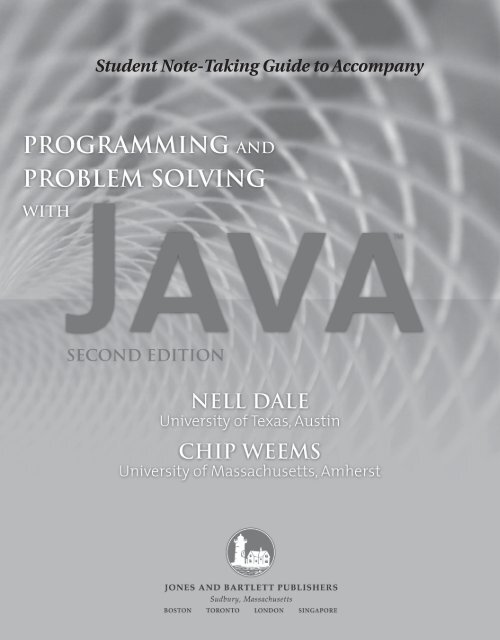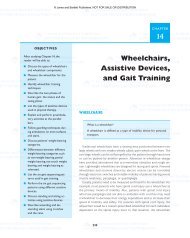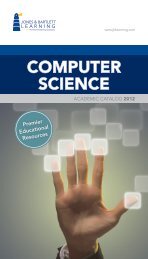Student Lecture Companion - Jones & Bartlett Learning
Student Lecture Companion - Jones & Bartlett Learning
Student Lecture Companion - Jones & Bartlett Learning
You also want an ePaper? Increase the reach of your titles
YUMPU automatically turns print PDFs into web optimized ePapers that Google loves.
World Headquarters<br />
<strong>Jones</strong> and <strong>Bartlett</strong> Publishers<br />
40 Tall Pine Drive<br />
Sudbury, MA 01776<br />
978-443-5000<br />
info@jbpub.com<br />
www.jbpub.com<br />
<strong>Jones</strong> and <strong>Bartlett</strong> Publishers Canada<br />
6339 Ormindale Way<br />
Mississauga, Ontario L5V 1J2<br />
Canada<br />
<strong>Jones</strong> and <strong>Bartlett</strong> Publishers International<br />
Barb House, Barb Mews<br />
London W6 7PA<br />
United Kingdom<br />
<strong>Jones</strong> and <strong>Bartlett</strong>’s books and products are available through most bookstores and online booksellers. To<br />
contact <strong>Jones</strong> and <strong>Bartlett</strong> Publishers directly, call 800-832-0034, fax 978-443-8000, or visit our website<br />
www.jbpub.com.<br />
Substantial discounts on bulk quantities of <strong>Jones</strong> and <strong>Bartlett</strong>’s publications are available to<br />
corporations, professional associations, and other qualified organizations. For details and specific<br />
discount information, contact the special sales department at <strong>Jones</strong> and <strong>Bartlett</strong> via the above contact<br />
information or send an email to specialsales@jbpub.com.<br />
Copyright © 2008 by <strong>Jones</strong> and <strong>Bartlett</strong> Publishers, Inc.<br />
All rights reserved. No part of the material protected by this copyright may be reproduced or utilized in<br />
any form, electronic or mechanical, including photocopying, recording, or by any information storage and<br />
retrieval system, without written permission from the copyright owner.<br />
ISBN-13: 978-0-7637-3402-2<br />
ISBN-10: 0-7637-3402-0<br />
6048<br />
Printed in the United States of America<br />
11 10 09 08 07 10 9 8 7 6 5 4 3 2 1
Table of Contents<br />
How This Book Can Help You Learn. . . . . . . . . . . . . . . . . . . . . . . . . . . . . . . . . . . iv<br />
Note-Taking Tips.. . . . . . . . . . . . . . . . . . . . . . . . . . . . . . . . . . . . . . . . . . . . . . . . . v<br />
Introduction to Object-Oriented Programming and Problem Solving. . . . . . . . . . . 1<br />
The Elements of Java. . . . . . . . . . . . . . . . . . . . . . . . . . . . . . . . . . . . . . . . . . . . . 21<br />
Classes and Methods. . . . . . . . . . . . . . . . . . . . . . . . . . . . . . . . . . . . . . . . . . . . . 41<br />
Numeric Types. . . . . . . . . . . . . . . . . . . . . . . . . . . . . . . . . . . . . . . . . . . . . . . . . . 55<br />
Branching and Method Algorithm Design. . . . . . . . . . . . . . . . . . . . . . . . . . . . . . 77<br />
Loops and Files.. . . . . . . . . . . . . . . . . . . . . . . . . . . . . . . . . . . . . . . . . . . . . . . . . 97<br />
Additional Control Structures. . . . . . . . . . . . . . . . . . . . . . . . . . . . . . . . . . . . . . 115<br />
Object-Oriented Software Engineering .. . . . . . . . . . . . . . . . . . . . . . . . . . . . . . 129<br />
Arrays.. . . . . . . . . . . . . . . . . . . . . . . . . . . . . . . . . . . . . . . . . . . . . . . . . . . . . . . 147<br />
Inheritance, Polymorphism, and Scope. . . . . . . . . . . . . . . . . . . . . . . . . . . . . . . 165<br />
Array-Based Lists. . . . . . . . . . . . . . . . . . . . . . . . . . . . . . . . . . . . . . . . . . . . . . . 183<br />
Data Structures and Collections.. . . . . . . . . . . . . . . . . . . . . . . . . . . . . . . . . . . . 205<br />
Recursion .. . . . . . . . . . . . . . . . . . . . . . . . . . . . . . . . . . . . . . . . . . . . . . . . . . . . 231<br />
Applets.. . . . . . . . . . . . . . . . . . . . . . . . . . . . . . . . . . . . . . . . . . . . . . . . . . . . . . 245
How This Book Can Help You Learn<br />
All of us have different learning styles. Some of us are visual learners, some more auditory,<br />
some learn better by doing an activity. Some students prefer to learn new material<br />
using visual aids. Some learn material better when they hear it in a lecture; others learn<br />
it better by reading it. Cognitive research has shown that no matter what your learning<br />
style, you will learn more if you are actively engaged in the learning process.<br />
This <strong>Student</strong> Note-Taking Guide will help you learn by providing a structure to your<br />
notes and letting you utilize all of the learning styles mentioned above. <strong>Student</strong>s don’t<br />
need to copy down every word their professor says or recopy their entire textbook. Do<br />
the assigned reading, listen in lecture, follow the key points your instructor is making,<br />
and write down meaningful notes. After reading and lectures, review your notes and<br />
pull out the most important points.<br />
The <strong>Student</strong> Note-Taking Guide is your partner and guide in note-taking. Your Guide<br />
provides you with a visual guide that follows the chapter topics presented in your textbook.<br />
If your instructor is using the PowerPoint slides that accompany the text, this guide<br />
will save you from having to write down everything that is on the slides. There is space<br />
provided for you to jot down the terms and concepts that you feel are most important to<br />
each lecture. By working with your Guide, you are seeing, hearing, writing, and, later,<br />
reading and reviewing. The more often you are exposed to the material, the better you<br />
will learn and understand it. Using different methods of exposure significantly increases<br />
your comprehension.<br />
Your Guide is the perfect place to write down questions that you want to ask your professor<br />
later, interesting ideas that you want to discuss with your study group, or reminders<br />
to yourself to go back and study a certain concept again to make sure that you really<br />
got it.<br />
Having organized notes is essential at exam time and when doing homework assignments.<br />
Your ability to easily locate the important concepts of a recent lecture will help<br />
you move along more rapidly, as you don’t have to spend time rereading an entire<br />
chapter just to reinforce one point that you may not have quite understood.<br />
Your Guide is a valuable resource. You’ve found a wonderful study partner!<br />
iv
Note-Taking Tips<br />
1. It is easier to take notes if you are not hearing the information for the first time.<br />
Read the chapter or the material that is about to be discussed before class. This will<br />
help you to anticipate what will be said in class, and have an idea of what to write<br />
down. It will also help to read over your notes from the last class. This way you can<br />
avoid having to spend the first few minutes of class trying to remember where you<br />
left off last time.<br />
2. Don’t waste your time trying to write down everything that your professor says. Instead,<br />
listen closely and only write down the important points. Review these important<br />
points after class to help remind you of related points that were made during<br />
the lecture.<br />
3. If the class discussion takes a spontaneous turn, pay attention and participate in the<br />
discussion. Only take notes on the conclusions that are relevant to the lecture.<br />
4. Emphasize main points in your notes. You may want to use a highlighter, special<br />
notation (asterisks, exclamation points), format (circle, underline), or placement on<br />
the page (indented, bulleted). You will find that when you try to recall these points,<br />
you will be able to actually picture them on the page.<br />
5. Be sure to copy down word-for-word specific formulas, laws, and theories.<br />
6. Hearing something repeated, stressed, or summed up can be a signal that it is an<br />
important concept to understand.<br />
7. Organize handouts, study guides, and exams in your notebook along with your lecture<br />
notes. It may be helpful to use a three-ring binder, so that you can insert pages<br />
wherever you need to.<br />
8. When taking notes, you might find it helpful to leave a wide margin on all four sides<br />
of the page. Doing this allows you to note names, dates, definitions, etc., for easy<br />
access and studying later. It may also be helpful to make notes of questions you<br />
want to ask your professor about or research later, ideas or relationships that you<br />
want to explore more on your own, or concepts that you don’t fully understand.<br />
9. It is best to maintain a separate notebook for each class. Labeling and dating your<br />
notes can be helpful when you need to look up information from previous lectures.<br />
10. Make your notes legible, and take notes directly in your notebook. Chances are you<br />
won’t recopy them no matter how noble your intentions. Spend the time you would<br />
have spent recopying the notes studying them instead, drawing conclusions and<br />
making connections that you didn’t have time for in class.<br />
11. Look over your notes after class while the lecture is still fresh in your mind. Fix illegible<br />
items and clarify anything you don’t understand. Do this again right before the<br />
next class.
Introduction to Object-Oriented Programming<br />
and Problem Solving<br />
Chapter 1<br />
Notes<br />
Introduction to Object-Oriented Programming and Problem Solving
Notes<br />
Chapter 1
Notes<br />
Introduction to Object-Oriented Programming and Problem Solving
Notes<br />
Chapter 1
Notes<br />
Introduction to Object-Oriented Programming and Problem Solving
Notes<br />
Chapter 1
Notes<br />
Introduction to Object-Oriented Programming and Problem Solving
Notes<br />
Chapter 1
Notes<br />
Introduction to Object-Oriented Programming and Problem Solving
Notes<br />
10 Chapter 1
Notes<br />
Introduction to Object-Oriented Programming and Problem Solving<br />
11
Notes<br />
12 Chapter 1
Notes<br />
Introduction to Object-Oriented Programming and Problem Solving<br />
13
Notes<br />
14 Chapter 1
Notes<br />
Introduction to Object-Oriented Programming and Problem Solving<br />
15
Notes<br />
16 Chapter 1
Notes<br />
Introduction to Object-Oriented Programming and Problem Solving<br />
17
Notes<br />
18 Chapter 1
Notes<br />
Introduction to Object-Oriented Programming and Problem Solving<br />
19
The Elements of Java<br />
Chapter 2<br />
Notes<br />
The Elements of Java<br />
21
Notes<br />
22 Chapter 2
Notes<br />
The Elements of Java<br />
23
Notes<br />
24 Chapter 2
Notes<br />
The Elements of Java<br />
25
Notes<br />
26 Chapter 2
Notes<br />
The Elements of Java<br />
27
Notes<br />
28 Chapter 2
Notes<br />
The Elements of Java<br />
29
Notes<br />
30 Chapter 2
Notes<br />
The Elements of Java<br />
31
Notes<br />
32 Chapter 2
Notes<br />
The Elements of Java<br />
33
Notes<br />
34 Chapter 2
Notes<br />
The Elements of Java<br />
35
Notes<br />
36 Chapter 2
Notes<br />
The Elements of Java<br />
37
Notes<br />
38 Chapter 2
Notes<br />
The Elements of Java<br />
39
Classes and Methods<br />
Chapter 3<br />
Notes<br />
Classes and Methods<br />
41
Notes<br />
42 Chapter 3
Notes<br />
Classes and Methods<br />
43
Notes<br />
44 Chapter 3
Notes<br />
Classes and Methods<br />
45
Notes<br />
46 Chapter 3
Notes<br />
Classes and Methods<br />
47
Notes<br />
48 Chapter 3
Notes<br />
Classes and Methods<br />
49
Notes<br />
50 Chapter 3
Notes<br />
Classes and Methods<br />
51
Notes<br />
52 Chapter 3
Notes<br />
Classes and Methods<br />
53
Notes<br />
54 Chapter 3
Numeric Types<br />
Chapter 4<br />
Notes<br />
Numeric Types<br />
55
Notes<br />
56 Chapter 4
Notes<br />
Numeric Types<br />
57
Notes<br />
58 Chapter 4
Notes<br />
Numeric Types<br />
59
Notes<br />
60 Chapter 4
Notes<br />
Numeric Types<br />
61
Notes<br />
62 Chapter 4
Notes<br />
Numeric Types<br />
63
Notes<br />
64 Chapter 4
Notes<br />
Numeric Types<br />
65
Notes<br />
66 Chapter 4
Notes<br />
Numeric Types<br />
67
Notes<br />
68 Chapter 4
Notes<br />
Numeric Types<br />
69
Notes<br />
70 Chapter 4
Notes<br />
Numeric Types<br />
71
Notes<br />
72 Chapter 4
Notes<br />
Numeric Types<br />
73
Notes<br />
74 Chapter 4
Notes<br />
Numeric Types<br />
75
Branching and Method Algorithm Design<br />
Chapter 5<br />
Notes<br />
Branching and Method Algorithm Design<br />
77
Notes<br />
78 Chapter 5
Notes<br />
Branching and Method Algorithm Design<br />
79
Notes<br />
80 Chapter 5
Notes<br />
Branching and Method Algorithm Design<br />
81
Notes<br />
82 Chapter 5
Notes<br />
Branching and Method Algorithm Design<br />
83
Notes<br />
84 Chapter 5
Notes<br />
Branching and Method Algorithm Design<br />
85
Notes<br />
86 Chapter 5
Notes<br />
Branching and Method Algorithm Design<br />
87
Notes<br />
88 Chapter 5
Notes<br />
Branching and Method Algorithm Design<br />
89
Notes<br />
90 Chapter 5
Notes<br />
Branching and Method Algorithm Design<br />
91
Notes<br />
92 Chapter 5
Notes<br />
Branching and Method Algorithm Design<br />
93
Notes<br />
94 Chapter 5
Notes<br />
Branching and Method Algorithm Design<br />
95
Notes<br />
96 Chapter 5
Loops and Files<br />
Chapter 6<br />
Notes<br />
Loops and Files<br />
97
Notes<br />
98 Chapter 6
Notes<br />
Loops and Files<br />
99
Notes<br />
100 Chapter 6
Notes<br />
Loops and Files<br />
101
Notes<br />
102 Chapter 6
Notes<br />
Loops and Files<br />
103
Notes<br />
104 Chapter 6
Notes<br />
Loops and Files<br />
105
Notes<br />
106 Chapter 6
Notes<br />
Loops and Files<br />
107
Notes<br />
108 Chapter 6
Notes<br />
Loops and Files<br />
109
Notes<br />
110 Chapter 6
Notes<br />
Loops and Files<br />
111
Notes<br />
112 Chapter 6
Notes<br />
Loops and Files<br />
113
Additional Control Structures<br />
Chapter 7<br />
Notes<br />
Additional Control Structures<br />
115
Notes<br />
116 Chapter 7
Notes<br />
Additional Control Structures<br />
117
Notes<br />
118 Chapter 7
Notes<br />
Additional Control Structures<br />
119
Notes<br />
120 Chapter 7
Notes<br />
Additional Control Structures<br />
121
Notes<br />
122 Chapter 7
Notes<br />
Additional Control Structures<br />
123
Notes<br />
124 Chapter 7
Notes<br />
Additional Control Structures<br />
125
Notes<br />
126 Chapter 7
Notes<br />
Additional Control Structures<br />
127
Notes<br />
128 Chapter 7
Object-Oriented Software Engineering<br />
Chapter 8<br />
Notes<br />
Object-Oriented Software Engineering<br />
129
Notes<br />
130 Chapter 8
Notes<br />
Object-Oriented Software Engineering<br />
131
Notes<br />
132 Chapter 8
Notes<br />
Object-Oriented Software Engineering<br />
133
Notes<br />
134 Chapter 8
Notes<br />
Object-Oriented Software Engineering<br />
135
Notes<br />
136 Chapter 8
Notes<br />
Object-Oriented Software Engineering<br />
137
Notes<br />
138 Chapter 8
Notes<br />
Object-Oriented Software Engineering<br />
139
Notes<br />
140 Chapter 8
Notes<br />
Object-Oriented Software Engineering<br />
141
Notes<br />
142 Chapter 8
Notes<br />
Object-Oriented Software Engineering<br />
143
Notes<br />
144 Chapter 8
Notes<br />
Object-Oriented Software Engineering<br />
145
Notes<br />
146 Chapter 8
Arrays<br />
Chapter 9<br />
Notes<br />
Arrays<br />
147
Notes<br />
148 Chapter 9
Notes<br />
Arrays<br />
149
Notes<br />
150 Chapter 9
Notes<br />
Arrays<br />
151
Notes<br />
152 Chapter 9
Notes<br />
Arrays<br />
153
Notes<br />
154 Chapter 9
Notes<br />
Arrays<br />
155
Notes<br />
156 Chapter 9
Notes<br />
Arrays<br />
157
Notes<br />
158 Chapter 9
Notes<br />
Arrays<br />
159
Notes<br />
160 Chapter 9
Notes<br />
Arrays<br />
161
Notes<br />
162 Chapter 9
Notes<br />
Arrays<br />
163
Notes<br />
164 Chapter 9
Inheritance, Polymorphism, and Scope<br />
Chapter 10<br />
Notes<br />
Inheritance, Polymorphism, and Scope<br />
165
Notes<br />
166 Chapter 10
Notes<br />
Inheritance, Polymorphism, and Scope<br />
167
Notes<br />
168 Chapter 10
Notes<br />
Inheritance, Polymorphism, and Scope<br />
169
Notes<br />
170 Chapter 10
Notes<br />
Inheritance, Polymorphism, and Scope<br />
171
Notes<br />
172 Chapter 10
Notes<br />
Inheritance, Polymorphism, and Scope<br />
173
Notes<br />
174 Chapter 10
Notes<br />
Inheritance, Polymorphism, and Scope<br />
175
Notes<br />
176 Chapter 10
Notes<br />
Inheritance, Polymorphism, and Scope<br />
177
Notes<br />
178 Chapter 10
Notes<br />
Inheritance, Polymorphism, and Scope<br />
179
Notes<br />
180 Chapter 10
Notes<br />
Inheritance, Polymorphism, and Scope<br />
181
Array-Based Lists<br />
Chapter 11<br />
Notes<br />
Array-Based Lists<br />
183
Notes<br />
184 Chapter 11
Notes<br />
Array-Based Lists<br />
185
Notes<br />
186 Chapter 11
Notes<br />
Array-Based Lists<br />
187
Notes<br />
188 Chapter 11
Notes<br />
Array-Based Lists<br />
189
Notes<br />
190 Chapter 11
Notes<br />
Array-Based Lists<br />
191
Notes<br />
192 Chapter 11
Notes<br />
Array-Based Lists<br />
193
Notes<br />
194 Chapter 11
Notes<br />
Array-Based Lists<br />
195
Notes<br />
196 Chapter 11
Notes<br />
Array-Based Lists<br />
197
Notes<br />
198 Chapter 11
Notes<br />
Array-Based Lists<br />
199
Notes<br />
200 Chapter 11
Notes<br />
Array-Based Lists<br />
201
Notes<br />
202 Chapter 11
Notes<br />
Array-Based Lists<br />
203
Data Structures and Collections<br />
Chapter 12<br />
Notes<br />
Data Structures and Collections<br />
205
Notes<br />
206 Chapter 12
Notes<br />
Data Structures and Collections<br />
207
Notes<br />
208 Chapter 12
Notes<br />
Data Structures and Collections<br />
209
Notes<br />
210 Chapter 12
Notes<br />
Data Structures and Collections<br />
211
Notes<br />
212 Chapter 12
Notes<br />
Data Structures and Collections<br />
213
Notes<br />
214 Chapter 12
Notes<br />
Data Structures and Collections<br />
215
Notes<br />
216 Chapter 12
Notes<br />
Data Structures and Collections<br />
217
Notes<br />
218 Chapter 12
Notes<br />
Data Structures and Collections<br />
219
Notes<br />
220 Chapter 12
Notes<br />
Data Structures and Collections<br />
221
Notes<br />
222 Chapter 12
Notes<br />
Data Structures and Collections<br />
223
Notes<br />
224 Chapter 12
Notes<br />
Data Structures and Collections<br />
225
Notes<br />
226 Chapter 12
Notes<br />
Data Structures and Collections<br />
227
Notes<br />
228 Chapter 12
Notes<br />
Data Structures and Collections<br />
229
Notes<br />
230 Chapter 12
Recursion<br />
Chapter 13<br />
Notes<br />
Recursion<br />
231
Notes<br />
232 Chapter 13
Notes<br />
Recursion<br />
233
Notes<br />
234 Chapter 13
Notes<br />
Recursion<br />
235
Notes<br />
236 Chapter 13
Notes<br />
Recursion<br />
237
Notes<br />
238 Chapter 13
Notes<br />
Recursion<br />
239
Notes<br />
240 Chapter 13
Notes<br />
Recursion<br />
241
Notes<br />
242 Chapter 13
Notes<br />
Recursion<br />
243
Applets<br />
Chapter 14<br />
Notes<br />
Applets<br />
245
Notes<br />
246 Chapter 14
Notes<br />
Applets<br />
247
Notes<br />
248 Chapter 14
Notes<br />
Applets<br />
249
Notes<br />
250 Chapter 14
Notes<br />
Applets<br />
251
Notes<br />
252 Chapter 14
Notes<br />
Applets<br />
253
Notes<br />
254 Chapter 14

















